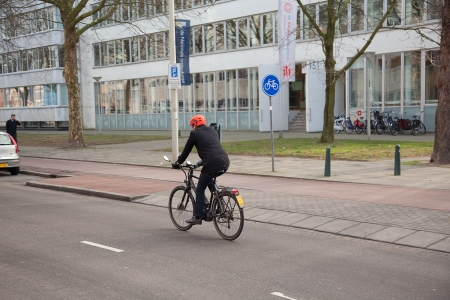Many of the measures improving road safety for conventional cyclists, will also improve road safety for pedelec riders. This mainly concerns infrastructural measures and measures focusing on stability improvement. See also SWOV fact sheet Cyclists. Measures that are particularly important for pedelec riders (as well), involve the higher cycling speed. These relate to helmet use, a rear-view mirror, improving recognisability of (speed) pedelecs and preventing the possibility to tune them up. In addition the stability of pedelecs could be improved.
Stimulating helmet use
A bicycle helmet reduces the risk of fatal brain injury by 70% [46]. If all cyclists aged 70 and over wore helmets, the Netherlands would have an annual reduction of 45 to 50 road deaths [47]. For more information about the effectiveness of bicycle helmets and how they work, see SWOV fact sheet Bicycle helmets. In the Netherlands, there is hardly anly support for general mandatory helmet use, but Danish practice has shown that stimulating voluntary use of bicycle helmets may result in a substantial increase in usage. Average helmet use in Danish city traffic increased from 33% in 2015 to 47% in 2020 [48].
Stimulating rear-view mirrors
Many over-65s ride on pedelecs. With increasing age, motor skills decline (see SWOV fact sheet Older road users). Among other things, this implies that looking over the shoulder and keeping balance at the same time becomes harder and harder. A rear-view mirror could remedy this problem. Moreover, younger cyclists will also benefit from rear-view mirrors that improve visibility of the traffic situation behind them. Engbers et al. [49] suggest a rear-view assistant. This supportive system could also warn about vehicles intending to overtake the cyclist, which could prevent startled reactions. As yet, only a prototype is available.
Improving recognisability
One of the concerns relating to the speed of a pedelec, is that it is underestimated by other road users who, therefore, make incorrect and dangerous (crossing) decis [21]. Improving the recognisability of pedelecs, possibly in combination with public communication about pedelec characteristics, may help improve other road users’ expectations. How to improve recognisability is subject to further research.
Prevention of tuning-up pedelecs
Pedelecs are technically easy to tune up. Tune-up sets are widely available on the internet and foreign research shows that a number of bicycle sellers is willing to assist (see the question How fast do pedelecs and speed pedelecs cycle?). To begin with, more focused and more frequent enforcement of the ban on tuned-up pedelecs on public roads will have to reduce their number. In addition, it should become technically impossible (or at least very hard) to tune up a pedelec. This is no easy task, as is apparent from the unsuccessful attempts to prevent tuning up of light mopeds (see SWOV fact sheet Mopeds and light mopeds).
Improving balance
Some say that a pedelec is better balanced when the motor and battery are in the lowest possible position. This indeed applies to a stationary pedelec but not to a riding one. The higher the centre of gravity, the easier it is to balance a pedelec [50]. Nowadays, the battery is more often integrated into the frame (the tube from the handlebars to the pedals). The battery in the frame and the motor in the middle ensure that the bicycle mass is in the middle, which also ensures sufficient pressure to the front wheel. Insufficient pressure to the front wheel may cause the wheel to slip, which immediately disturbs the balance.
